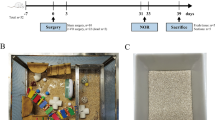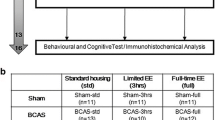Abstract
Environment enrichment (EE) has been demonstrated to improve the cognitive impairment that is induced by chronic cerebral hypoperfusion (CCH), but the underlying mechanism has not yet been elucidated. This study aimed to investigate the role of endogenous neuroprotection in EE-induced cognitive improvement in rats with CCH. Permanent bilateral common carotid artery occlusions (2-vessel occlusions (2VOs)) were performed to induce CCH in male adult Wistar rats. Four weeks after the surgeries, the rats were exposed to enriched environments for 4 weeks (6 h/day). Subsequently, we assessed the effects of EE on cognitive function, brain histone acetylation levels, neuroprotection-related transcription factors (i.e., cAMP response element-binding protein (CREB), phospho-CREB (p-CREB), hypoxia-inducible factor 1 (HIF-1) α, and nuclear regulatory factor 2 (Nrf2)), and oxidative stress and histological changes in the brain. After 2VO, the rats exposed to the EE treatment exhibited increased acetylation of histone 4 and increased p-CREB and Nrf2 protein levels in the brain. HIF-1α levels were increased after 2VO and reduced after EE treatment. The oxidative damage, histopathological changes in the brain, and spatial learning and memory impairments induced by 2VO were subsequently restored after EE treatment. These data indicate that EE promotes the acetylation of histone 4, regulates some neuroprotection-related transcription factors, attenuates oxidative damage, and protects against the histopathological damage to the brain induced by CCH. Together, the effects of EE in CCH rats might contribute to the recovery of spatial learning and memory.









Similar content being viewed by others
Abbreviations
- EE:
-
Environment enrichment
- CCH:
-
Chronic cerebral hypoperfusion
- 2VO:
-
2-Vessel occlusion
- AD:
-
Alzheimer’s disease
- VaD:
-
Vascular dementia
- CREB:
-
cAMP response element-binding protein
- p-CREB:
-
Phospho-CREB
- Nrf2:
-
Nuclear regulatory factor 2
- HIF-1α:
-
Hypoxia-inducible factor 1α
- GFAP:
-
Glial fibrillary acidic protein
- Iba-1:
-
Ionized calcium binding adapter molecule 1 (a marker of microglia)
- 4-HNE:
-
4-Hydroxynonenal
References
Benarroch EE (2009) Hypoxia-induced mediators and neurologic disease. Neurology 73:560–565
Calkins MJ, Johnson DA, Townsend JA, Vargas MR, Dowell JA, Williamson TP, Kraft AD, Lee JM, Li J, Johnson JA (2009) The Nrf2/ARE pathway as a potential therapeutic target in neurodegenerative disease. Antioxid Redox Signal 11:497–508
Cechetti F, Worm PV, Lovatel G, Moysés F, Siqueira IR, Netto CA (2012) Environmental enrichment prevents behavioral deficits and oxidative stress caused by chronic cerebral hypoperfusion in the rat. Life Sci 91:29–36
Cheng B, Mattson MP (1994) NT-3 and BDNF protect CNS neurons against metabolic/excitotoxic insults. Brain Res 640:56–67
Choy M, Ganesan V, Thomas DL, Thornton JS, Proctor E, King MD, van derWeerd L, Gadian DG, Lythgoe MF (2006) The chronic vascular and haemodynamic response after permanent bilateral common carotid occlusion in newborn and adult rats. J Cereb Blood Flow Metab 26:1066–1075
Chuang DM, Leng Y, Marinova Z, Kim HJ, Chiu CT (2009) Multiple roles of HDAC inhibition in neurodegenerative conditions. Trends Neurosci 32:591–601
de la Torre JC (2002) Vascular basis of Alzheimer’s pathogenesis. Ann N Y Acad Sci 977:196–215
Farkas E, Luiten PG, Bari F (2007) Permanent, bilateral common carotid artery occlusion in the rat: a model for chronic cerebral hypoperfusion-related neurodegenerative diseases. Brain Res Rev 54:162–180
Fischer A, Sananbenesi F, Wang X, Dobbin M, Tsai LH (2007) Recovery of learning and memory is associated with chromatin remodelling. Nature 447:178–182
Gobbo OL, O’Mara SM (2004) Impact of enriched-environment housing on brain-derived neurotrophic factor and on cognitive performance after a transient global ischemia. Behav Brain Res 152:231–241
Gorelick PB, Scuteri A, Black SE, Decarli C, Greenberg SM, Iadecola C, Launer LJ, Laurent S, Lopez OL, Nyenhuis D, Petersen RC, Schneider JA, Tzourio C, Arnett DK, Bennett DA, Chui HC, Higashida RT, Lindquist R, Nilsson PM, Roman GC et al (2011) Vascular contributions to cognitive impairment and dementia: a statement for healthcare professionals from the American Heart Association/American Stroke Association. Stroke 42:2672–2713
Herring A, Blome M, Ambree O, Sachser N, Paulus W, Keyvani K (2010) Reduction of cerebral oxidative stress following environmental enrichment in mice with Alzheimer-like pathology. Brain Pathol 20:166–175
Karuppagounder SS, Ratan RR (2012) Hypoxia-inducible factor prolyl hydroxylase inhibition: robust new target or another big bust for stroke therapeutics? J Cereb Blood Flow Metab 32:1347–1361
Kitagawa K (2007) CREB and cAMP response element-mediated gene expression in the ischemic brain. FEBS J 274:3210–3217
Liu H, Zhang J (2012) Cerebral hypoperfusion and cognitive impairment: the pathogenic role of vascular oxidative stress. Int J Neurosci 122:494–499
Nithianantharajah J, Hannan AJ (2006) Enriched environments, experience-dependent plasticity and disorders of the nervous system. Nat Rev Neurosci 7:697–709
Osawa A, Maeshima S, Shimamoto Y, Maeshima E, Sekiguchi E, Kakishita K, Ozaki F, Moriwaki H (2004) Relationship between cognitive function and regional cerebral blood low in different types of dementia. Disabil Rehabil 26:739–745
Ruitenberg A, denHeijer T, Bakker SL, van Swieten JC, Koudstaal PJ, Hofman A, Breteler MM (2005) Cerebral hypoperfusion and clinical onset of dementia: the Rotterdam study. Ann Neurol 57:789–794
Shibata M, Ohtani R, Ihara M, Tomimoto H (2004) White matter lesions and glial activation in a novel mouse model of chronic cerebral hypoperfusion. Stroke 35:2598–2603
Spina MB, Squinto SP, Miller J, Lindsay RM, Hyman C (1992) Brain-derived neurotrophic factor protects dopamine neurons against 6-hydroxydopamine and N-methyl-4- phenylpyridinium ion toxicity: involvement of the glutathione system. J Neurochem 59:99–106
Stranaha AM, Lee K, Becker KG, Zhang Y, Maudsley S, Martin B, Cutler RG, Mattson MP (2010) Hippocampal gene expression patterns underlying the enhancement of memory by running in aged mice. Neurobiol Aging 31:1937–1949
Stranahan AM, Mattson MP (2012) Recruiting adaptive cellular stress responses for successful brain ageing. Nature 13:209–216
Sun H, Zhang J, Zhang L, Liu H, Zhu H, Yang Y (2010) Environmental enrichment influences BDNF and NR1 levels in the hippocampus and restores cognitive impairment in chronic cerebral hypoperfused rats. Curr Neurovasc Res 7:268–280
Vecsey CG, Hawk JD, Lattal KM, Stein JM, Fabian SA, Attner MA, Cabrera SM, McDonough CB, Brindle PK, Abel T, Wood MA (2007) Histone deacetylase inhibitors enhance memory and synaptic plasticity via CREB:CBP-dependent transcriptional activation. J Neurosci 27:6128–6140
Xu Y, Zhang JJ, Xiong L, Zhang L, Sun D, Liu H (2010) Green tea polyphenols inhibit cognitive impairment induced by chronic cerebral hypoperfusion via modulating oxidative stress. J Nutr Biochem 21:741–748
Yang Y, Zhang J, Liu H, Wang J, Xin J, Deng M (2013) Changes in levels of hypoxia-induced mediators in rat hippocampus during chronic cerebral hypoperfusion. Neurochem Res 38:2433–2439
Yang Y, Zhang J, Liu H, Zhang L (2014) Change of Nrf2 expression in rat hippocampus in a model of chronic cerebral hypoperfusion. Int J Neurosci 124:577–584
Zhang L, Zhang J, Sun H, Zhu H, Liu H, Yang Y (2013) An enriched environment elevates corticosteroid receptor levels in the hippocampus and restores cognitive function in a rat model of chronic cerebral hypoperfusion. Pharmacol Biochem Behav 103:693–700
Acknowledgments
This work was supported by the National Natural Science Foundation of China (Grant number: 81171029 and 81000471)
Conflict of Interest
The authors declared that there are no conflicts of interest.
Author information
Authors and Affiliations
Corresponding author
Additional information
Ying Yang and Li Xiong contributed equally to this work.
Rights and permissions
About this article
Cite this article
Yang, Y., Zhang, J., Xiong, L. et al. Cognitive Improvement Induced by Environment Enrichment in Chronic Cerebral Hypoperfusion Rats: a Result of Upregulated Endogenous Neuroprotection?. J Mol Neurosci 56, 278–289 (2015). https://doi.org/10.1007/s12031-015-0529-2
Received:
Accepted:
Published:
Issue Date:
DOI: https://doi.org/10.1007/s12031-015-0529-2




